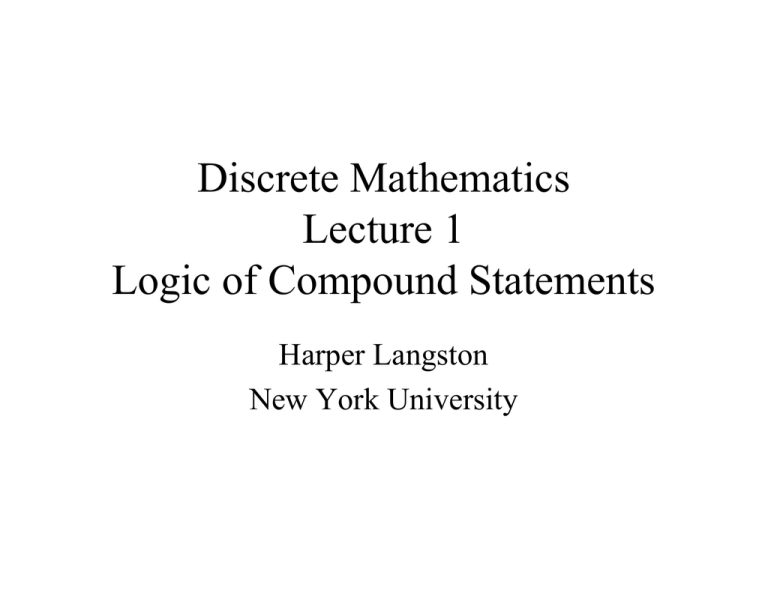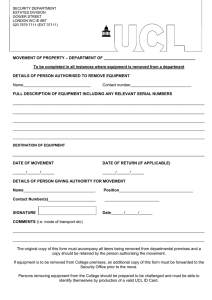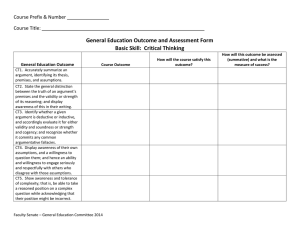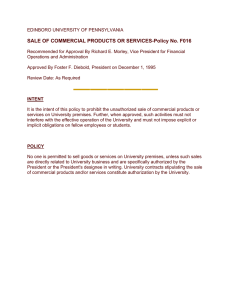Discrete Mathematics Lecture 1 Logic of Compound Statements
advertisement

Discrete Mathematics Lecture 1 Logic of Compound Statements Harper Langston New York University Administration • Class Web Site http://cs.nyu.edu/courses/summer05/G22.2340-001/ • Mailing List Subscribe at http://cs.nyu.edu/mailman/listinfo/g22_2340_001_su05 Messages to: G22_2340_001_su05@cs.nyu.edu • TA/Office Hours, etc Logic of Statements • • • • • Logical Form and Logical Equivalence Conditional Statements Valid and Invalid Arguments Digital Logic Circuits Number Systems & Circuits for Addition Logical Form • Initial terms in logic: sentence, true, false • Statement (proposition) is a sentence that is true or false but not both • Compound statement is a statement built out of simple statements using logical operations: negation, conjunction, disjunction Logical Form • Truth table • Precedence of logical operations • English words to logic: – It is not hot but it is sunny – It is neither hot nor sunny • Statement form (propositional form) is an expression made up of statement variables and logical connectives (operators) • Exclusive OR: XOR Logical Form • Truth table for (~p ∧ q) ∨ (q ∧ ~r) • Two statements are called logically equivalent if and only if (iff) they have identical truth tables • Double negation • Non-equivalence: ~(p ∨ q) vs ~p ∨ ~q • De Morgan’s Laws: – The negation of and AND statement is logically equivalent to the OR statement in which component is negated – The negation of an OR statement is logically equivalent to the AND statement in which each component is negated Logical Form • Applying De-Morgan’s Laws: – Write negation for • The bus was late or Tom’s watch was slow • -1 < x <= 4 • Tautology is a statement that is always true regardless of the truth values of the individual logical variables • Contradiction is a statement that is always false regardless of the truth values of the individual logical variables Logical Equivalence • Commutative laws: p ∧ q = q ∧ p, p ∨ q = q ∨ p • Associative laws: (p ∧ q) ∧ r = p ∧ (q ∧ r), (p ∨ q) ∨ r = p ∨ (q ∨ r) • Distributive laws: p ∧ (q ∨ r) = (p ∧ q) ∨ (p ∧ r) p ∨ (q ∧ r) = (p ∨ q) ∧ (p ∨ r) • Identity laws: p ∧ t = p, p ∨ c = p • Negation laws: p ∨ ~p = t, p ∧ ~p = c • Double negative law: ~(~p) = p • Idempotent laws: p ∧ p = p, p ∨ p = p • De Morgan’s laws: ~(p ∧ q) = ~p ∨ ~q, ~(p ∨ q) = ~p ∧ ~q • Universal bound laws: p ∨ t = t, p ∧ c = c • Absorption laws: p ∨ (p ∧ q) = p, p ∧ (p ∨ q) = p • Negation of t and c: ~t = c, ~c = t Conditional Statements • If something, then something: p Æ q, p is called the hypothesis and q is called the conclusion • The only combination of circumstances in which a conditional sentence is false is when the hypothesis is true and the conclusion is false • A conditional statements is called vacuously true or true by default when its hypothesis is false • Among ∧, ∨, ~ and Æ operations, Æ has the lowest priority Conditional Statements Write truth table for: p ∧ q Æ ~p Show that (p ∨ q) Æ r = (p Æ r) ∧ (q Æ r) Representation of Æ: p Æ q = ~p ∨ q Re-write using if-else: Either you get in class on time, or you risk missing some material • Negation of Æ: ~(p Æ q) = p ∧ ~q • Write negation for: If it is raining, then I cannot go to the beach • • • • Conditional Statements • Contrapositive p Æ q is another conditional statement ~q Æ ~p • A conditional statement is equivalent to its contrapositive • The converse of p Æ q is q Æ p • The inverse of p Æ q is ~p Æ ~q • Conditional statement and its converse are not equivalent • Conditional statement and its inverse are not equivalent Conditional Statements • The converse and the inverse of a conditional statement are equivalent to each other • p only if q means ~q Æ ~p, or p Æ q • Biconditional of p and q means “p if and only if q” and is denoted as p ↔ q • r is a sufficient condition for s means “if r then s” • r is a necessary condition for s means “if not r then not s” Exercises • Write contrapositive, converse and inverse statements for: – If P is a square, then P is a rectangle – If today is Thanksgiving, then tomorrow is Friday – If c is rational, then the decimal expansion of r is repeating – If n is prime, then n is odd or n is 2 – If x is nonnegative, then x is positive or x is 0 – If Tom is Ann’s father, then Jim is her uncle and Sue is her aunt – If n is divisible by 6, then n is divisible by 2 and n is divisible by 3 Arguments • An argument is a sequence of statements. All statements except the final one are called premises (or assumptions or hypotheses). The final statement is called the conclusion. • An argument is considered valid if from the truth of all premises, the conclusion must also be true. • The conclusion is said to be inferred or deduced from the truth of the premises Arguments • Test to determine the validity of the argument: – Identify the premises and conclusion of the argument – Construct the truth table for all premises and the conclusion – Find critical rows in which all the premises are true – If the conclusion is true in all critical rows then the argument is valid, otherwise it is invalid • Example of valid argument form: – Premises: p ∨ (q ∨ r) and ~r, conclusion: p ∨ q • Example of invalid argument form: – Premises: p Æ q ∨ ~r and q Æ p ∧ r, conclusion: p Æ r Valid Argument-Forms • Modus ponens (method of affirming): – Premises: p Æ q and p, conclusion: q • Modus tollens (method of denying): – Premises: p Æ q and ~q, conclusion: ~p • Disjunctive addition: – Premises: p, conclusion: p | q – Premises: q, conclusion: p | q • Conjunctive simplification: – Premises: p & q, conclusion: p, q Valid Argument-Forms • Disjunctive Syllogism: – Premises: p | q and ~q, conclusion: p – Premises: p | q and ~p, conclusion: q • Hypothetical Syllogism – Premises: p Æ q and q Æ r, conclusion: p Æ r • Dilemma: proof by division into cases: – Premises: p | q and p Æ r and q Æ r, conclusion: r Complex Deduction • Premises: – If my glasses are on the kitchen table, then I saw them at breakfast – I was reading the newspaper in the living room or I was reading the newspaper in the kitchen – If I was reading the newspaper in the living room, then my glasses are on the coffee table – I did not see my glasses at breakfast – If I was reading my book in bed, then my glasses are on the bed table – If I was reading the newspaper in the kitchen, then my glasses are on the kitchen table • Where are the glasses? Fallacies • A fallacy is an error in reasoning that results in an invalid argument • Three common fallacies: – Vague or ambiguous premises – Begging the question (assuming what is to be proved) – Jumping to conclusions without adequate grounds • Converse Error: – Premises: p Æ q and q, conclusion: p • Inverse Error: – Premises: p Æ q and ~p, conclusion: ~q Fallacies • It is possible for a valid argument to have false conclusion and for an invalid argument to have a true conclusion: – Premises: if John Lennon was a rock star, then John Lennon had red hair, John Lennon was a rock star; Conclusion: John Lennon had red hair – Premises: If New York is a big city, then New York has tall buildings, New York has tall buildings; Conclusion: New York is a big city Contradiction • Contradiction rule: if one can show that the supposition that a statement p is false leads to a contradiction , then p is true. • Knight is a person who always says truth, knave is a person who always lies: – A says: B is a knight – B says: A and I are of opposite types What are A and B? Digital Logic Circuits • Digital Logic Circuit is a basic electronic component of a digital system • Values of digital signals are 0 or 1 (bits) • Black Box is specified by the signal input/output table • Three gates: NOT-gate, AND-gate, OR-gate • Combinational circuit is a combination of logical gates • Combinational circuit always correspond to some boolean expression, such that input/output table of a table and a truth table of the expression are identical Digital Logic Circuits • A recognizer is a circuit that outputs 1 for exactly one particular combination of input signals and outputs 0’s for all other combinations • Multiple-input AND and OR gates • Finding a circuit that corresponds to a given input/output table: – Construct equivalent boolean expression using disjunctive normal form: for all outputs of 1 construct a conjunctive form based on the truth table row. All conjunctive forms are united using disjunction – Construct a digital logic circuit equivalent to the boolean expression Digital Logic Circuits • Design a circuit for the following output: (0, 0, 1, 1, 0, 0, 1, 0) • Two digital logic circuits are equivalent iff their input/output tables are identical • Simplification of circuits • Scheffer stroke (NAND) • Peirce arrow (NOR) Number Systems • Decimal number system • Binary number system • Conversion between decimal and binary numbers • Binary addition and subtraction Digital Circuits for Addition • Half Adder – addition of two bits • Full Adder – addition of two bits and a carry • Parallel Adder – addition of multi-bit numbers Negative Numbers • Two’s complement of a positive integer a relative to a fixed bit length n is the binary representation of 2^n – a • To find an 8-bit complement: – Write 8-bit binary representation of the number – Flip all bits (one’s complement) – Add 1 to the obtained binary • Addition of negative numbers Hexadecimal Numbers • Hexadecimal notation is a number system with base 16 • Digits of hexadecimal number system • Conversion between hexadecimal and binary and hexadecimal and decimal systems




